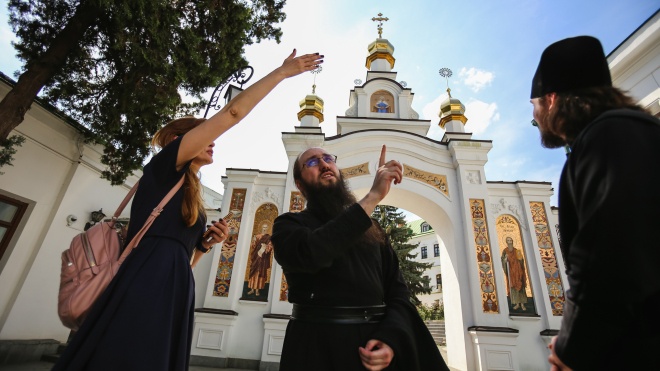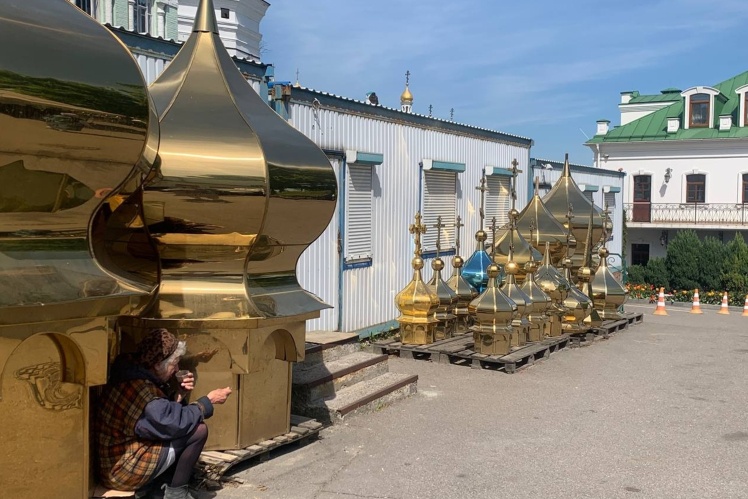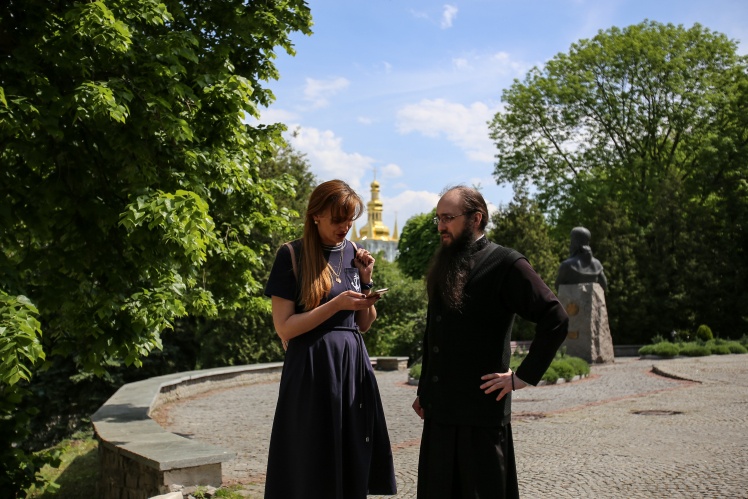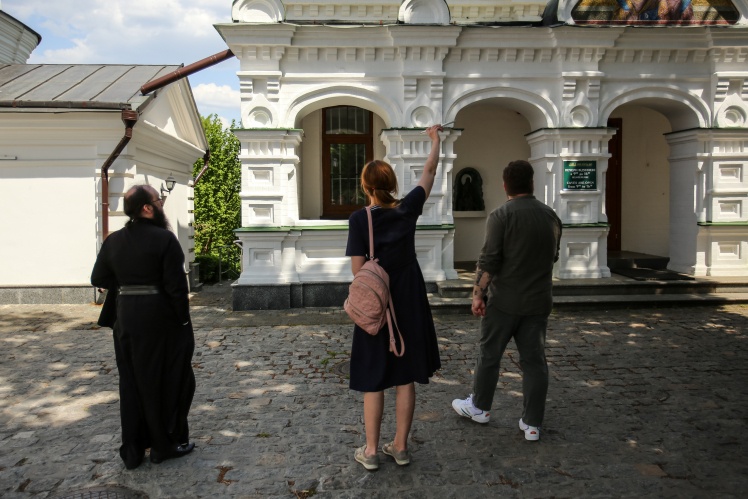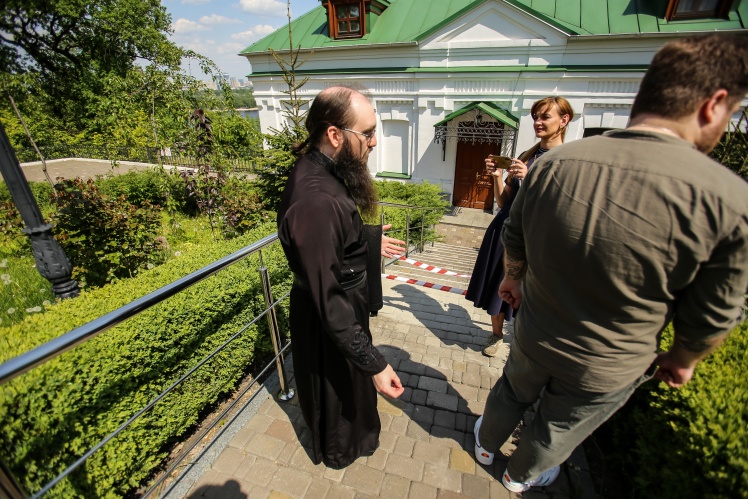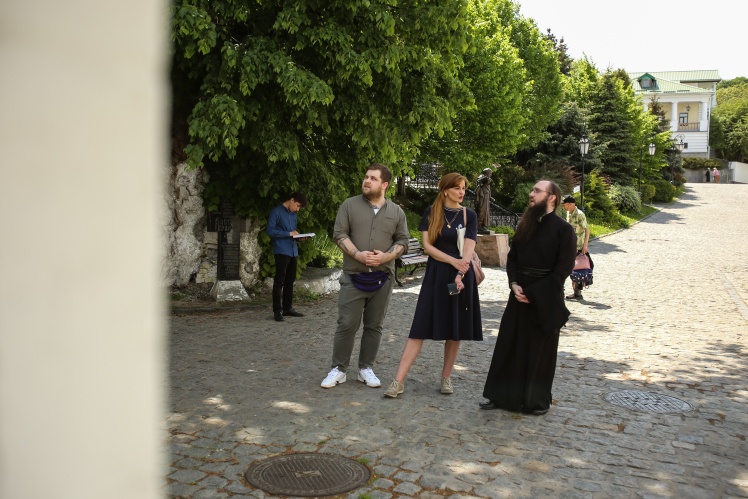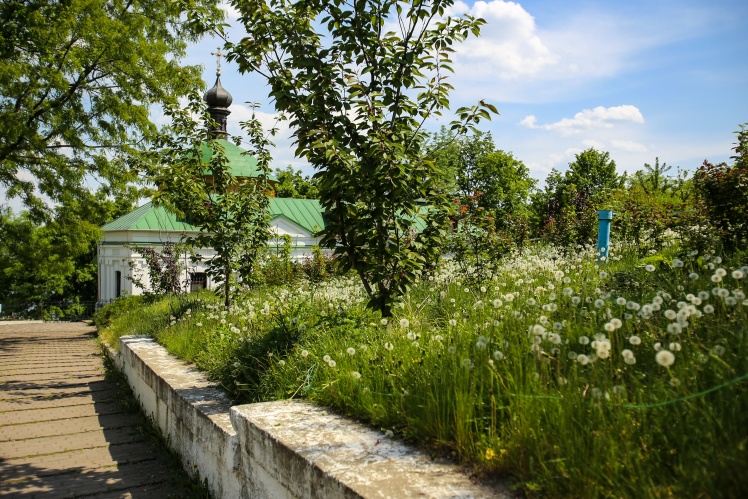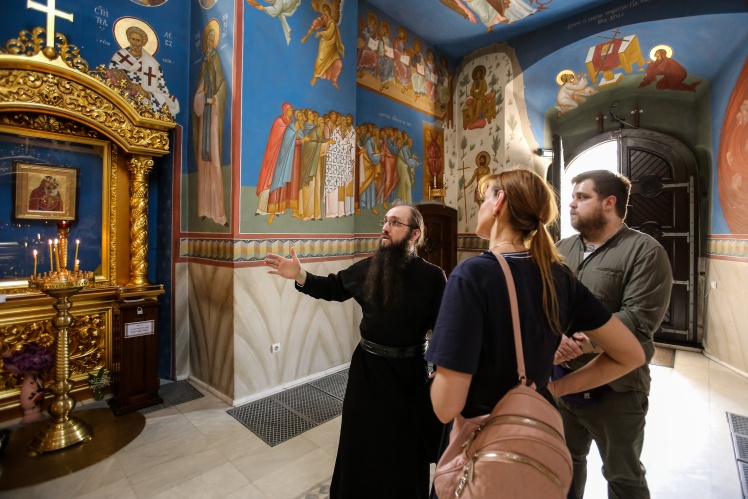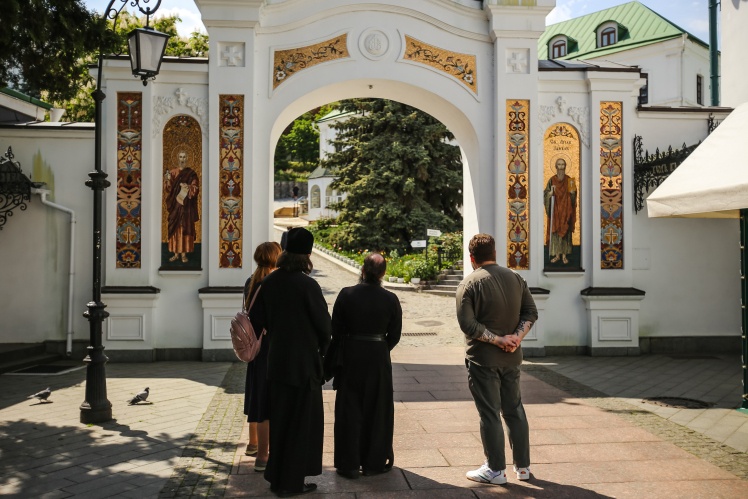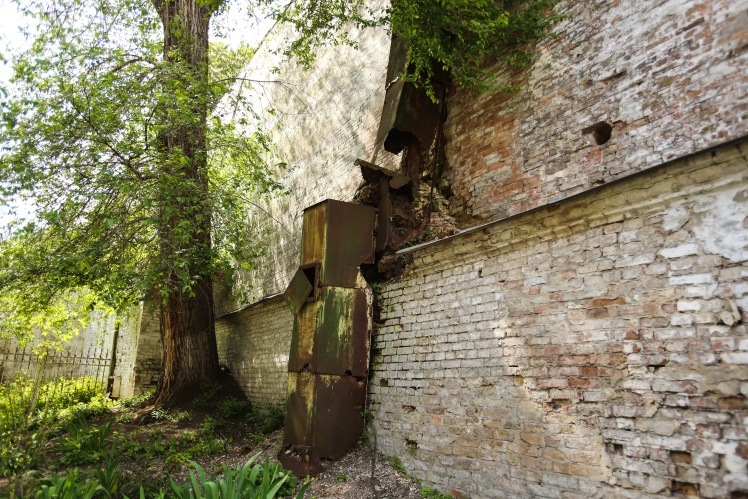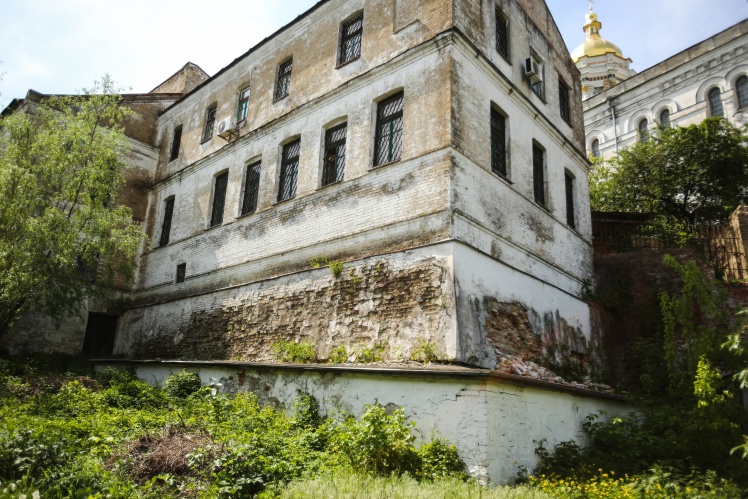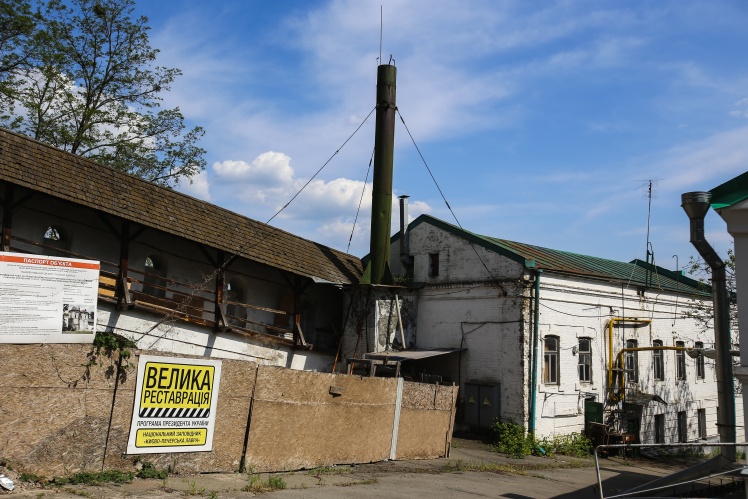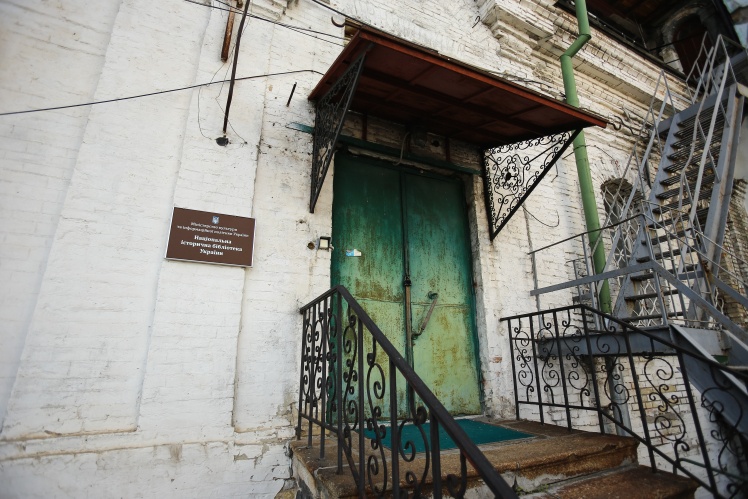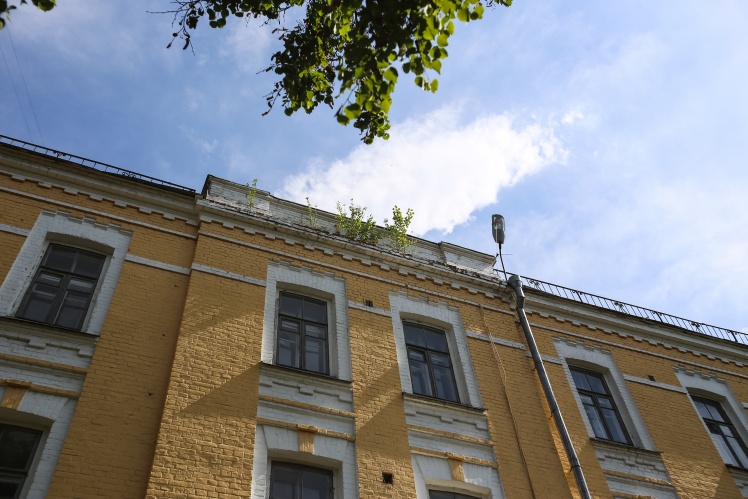In the courtyard of the monastery, priests of the UOC MP hold a service — behind a barrier and a police border. They hide from the sun under a large umbrella with the Coca-Cola logo. There are not many people on duty — itʼs the height of the working day. Here, the church distributes free lunches — disposable plates with pearl barley and meat, bread, and tea are on the tables.
A man in his twenties is standing in front of the barrier. Heʼs dirty, blood stained on his lips. He lives on the street.
"Bring out the sandwiches, I want to eat," he tells us.
“Come in and take it,” we answer. The man explains that he lost his passport, and without it the police will not let him through the barrier.
“We are journalists, come in, donʼt be afraid, we will tell the police that you are with us.”
The man takes a few steps, but is stopped by the police.
“Where are you going without documents! Weʼve told you already, donʼt come!”
“Well, guys, heʼs hungry,” we say. “Let him in under our responsibility, he will just take a plate and leaves.”
“Woman, if you want to help, bring him food,” the policeman answers, turning to Ghanna.
We take a plate with porridge and sandwiches and pass it to a stranger. At that moment the phone rings.
“Christ is risen,” Archimandrite Mytrofan greets us. “Iʼm at the exams, I will send the seminarian for you. Be near the police.”
In the courtyard of the Lavra, where the UOC MP conducts a service.
Ganna Mamonova / "Babel"
A few minutes later, Dmytro, a thin young man in a black robe, runs up to us. He extends his hand to shake: “Christ is risen!” On the way, we ask him about studying at the seminary. He says he joined it last year. Originally heʼs from the Bukovyna region, he went to church with his parents from an early age, they supported him on his way to become a priest. Only he does not yet know whether he wants to become a monk or a parish priest in the future. Today Dmytro passed two exams — on the word of God and on the history of Ukraine. Like ordinary students, he pulled out tickets with questions.
“You are from Bukovyna, and you study at the seminary of the Moscow Patriarchate, why not at the OCU?” we ask.
The guy answers that the Lavra is the center of world Orthodoxy, there is no other like it.
“Is Archimandrite Mytrofan a strict teacher?”
“No, he always very attentive. He teaches history and culture,” says Dmytro.
Young men run out of the seminary, exhaling — they have passed their exams. Mytrofan slowly comes out behind them. Archimandrite is thirty-five years old, in addition to teaching, he is also the secretary of the Academic Council of the Kyiv Theological Academy and UOC MP Seminary. He comes from the Cherkasy region in central Ukraine, speaks Ukrainian fluently. He wears a black robe fastened with a leather belt and a black knitted vest.
“The walls in the academy are thick — itʼs cold there,” he says and takes off his vest. Itʼs hot outside.
Believers and seminarians bow to him and ask for his blessing.
“Father Nestor will come later — he is still taking exams,” continues Mytrofan.
To describe how the monastery reconstructed the Lower Lavra, he begins with the seminary. He says that this is a building of the 19th century. It was in terrible condition, piles had to be driven into the ground to strengthen it. The interior was remodeled, the windows were changed. As a result, the building looks modern.
“The foundation was covered with modern tiles. Is this possible on a historical building?”
“Why not? What should we have cover the foundation with? The tile separates the basement level from the entire structure,” answers Mytrofan. He says that the reserve handed over the Lower Lavra to the monastery on the condition that there will be repairs, reconstruction, and proper maintenance of the territory. The monastery fulfills these conditions.
With Archimandrite Mytrofan near the building of the spiritual academy. On the household square. Archimandrite Mytrofan.
Герман Крігер / «Бабель»
We walk through the gardens of the Lower Lavra, the archimandrite leads us along one of the streets in the direction of the Far Caves. The monks go to the meeting — although the reserve has terminated the lease agreement with the monastery, they have not left.
“[For the right to live in the Lavra] we will fight to the end,” says Mytrofan. “Why do we have to leave? It isnʼt clear what to do with the theological academy and seminary. We belong to the Ukrainian Orthodox Church, but we are a separate legal entity from the monastery. The reserve did not hand over the lease termination documents to us.”
“Was there a separate agreement with the seminary?”
“I understand that the state now benefits from calling us all "monks of the Ukrainian Orthodox Church", but according to the documents, this is not the case. In general, there are many mistakes in the documents of the reserve, which is why we are appealing the decision in court.
According to him, the commission of the Ministry of Culture and Information Policy of Ukraine, which has been describing the buildings of the monastery since April 2023, did not make any comments about illegal construction or the inappropriate condition of the premises.
“Legally, much of what everyone is talking about does not exist, you understand? Let them hand over the documents and conclusions to us, we will read them,” says Mytrofan.
The reserveʼs deputy director Kostyantyn Krayniy said in a comment to Babel that the reserve does not have separate lease agreements with the seminary: "In 2013, the government of Mykola Azarov gave the UOC MP monastery for lifetime free use of all 79 buildings of the Lower Lavra. Then the monastery subleased part of the buildings to the theological academy and seminary."
The "Monastery Cellar" is located in the Household Yard of the Lower Lavra, next to the "Brotherʼs Building" with cells. On one side, the cellar has one floor with an attic, but on the side of the slope there are two floors. The three-story "Economic block" with an attic stands next to the cellar. If you approach the building from the front entrance, it seems that it is one story. Additional floors are hidden on the other side, where the slope is lower.
Герман Крігер / «Бабель»
We go out to Household Square — there are three new buildings of the monastery: the "Brotherʼs Building", where the cells are located, the "Cellar" for storing food, and the administrative "Economic Block". They were built in 2012-2016, and in 2017 the State Inspection of Architecture and Urban Planning arrested them as illegal construction. The archimandrite is surprised that the buildings could not have appeared without the consent of the reserve. He remembers the words of the governor of the Lavra Pavlo — he said that there were buildings here before the Second World War, but they were destroyed, so the monastery built new ones on the old foundation.
The reserveʼs comment: "Over a thousand years, the entire territory of the Lavra has somehow been built up, so there are always remnants of the old foundation somewhere. But this does not give anyone permission to build without approval, because the reserve is a UNESCO World Heritage site."
"Itʼs just restoring," says Mytrofan.
“And at whose expense was the church repaired and built — state or UOC MPʼs?”
“Vicar Pavlo may know this. He is currently under house arrest, but you can write him a request. As far as I know, the state allocates money for the maintenance of the caves, and we restore the rest at our own expense,” he answers.
“Three new buildings have attic floors — cut-out windows in the roof. You are a historian. Donʼt modern windows on historical buildings sting your eyes?”
Mytrofan says that the three new buildings with attics are a stylization for the old. Therefore, he does not see a problem. It may not have been necessary to do this in historical buildings, but the monastery made attics because it did not have enough space. In 2007, Pavlo as a deputy of Kyiv City Council appealed to the deputies of the Verkhovna Rada, the President and government officials to give the entire territory of the Lavra to the UOC MP. But they didnʼt do it.
“Maybe if the reserve was given to us, there would be no need to build,” says Mytrofan. “[The former President of Ukraine Viktor] Yushchenko promised to help us, but it didnʼt work out. We are accused of saying that Yanukovych was "our president". And what did he do for the church? Nothing.”
“He gave you a lifetime lease of the Lower Lavra, and now the government has canceled this decision.”
“Well, this is an exception. But in general... Perhaps Yushchenko had the best attitude towards churches. He did not single out anyone — neither us, nor the Kyiv Patriarchate,” says Mytrofan.
Entrance to the Far Caves. In the monastery gardens.
Герман Крігер / «Бабель»
Near the entrance to the Far Caves is a monument to Cyril and Methodius. The reserve assures that the monastery erected it and four other monuments on the territory of the Lavra without permission. The archimandrite denies and says that everything has been agreed with the scientific council of the reserve. And ambassadors of foreign countries and representatives of the authorities came to the opening of the monuments at different times.
The entrance to the Far Caves is a building of the 18th century. Above its door, the monastery made a colored mosaic on a golden background. Its appearance was approved by the governor Pavlo.
“Go to Saint Sophia of Kyiv, all the mosaics shine there too, because it is a Byzantine canon,” says Mytrofan.
The reserveʼs comment: "The reserve did not allow mosaics to be made, because they never existed on the historical buildings of the Lavra — neither on the gates, nor on the cells, nor on the temples. It is known from the annals that the only mosaic painting in the Lavra was in the Dormition Cathedral during the times of Kyivan Rusʼ.”
With irony, he draws our attention to the tiles with which the sidewalks are paved. He says that in the 19th century it was not there, but now it is pleasant to walk on it and not lose your feet. Then there were no handrails along the slope to hold on and not fall.
“We should be criticized for that, too,” smiles Mytrofan. And he adds that the cobblestones must be repaired every year: they are constantly destroyed by the water that floods the Lavra.
Monastery gardens. Church of the Nativity of the Most Holy Theotokos, which was repaired and painted by the UOC MP.
Герман Крігер / «Бабель»
The slopes of the Lavra are strewn with dandelions — the archimandrite says that this is the first year in his memory that the lawn was not mowed on time. The vicar of the Lavra took away the lawnmowers and other equipment in March 2022.
“This is the property of the monastery, some of the things were taken from here. Although monks continue to live in cells,” Mytrofan explains.
We enter the Church of the Nativity of the Most Holy Theotokos, which was built in the 17th century. The monastery is proud of its restoration. During the renovation in 2016, the plaster was knocked off because it was eaten by mold. It is not known if the church was ever painted, in Soviet times the walls were simply whitewashed. The UOC painted it — saints are depicted on a blue background. Under the ceiling is a gilded chandelier, the iconostasis is also gilded.
“Temples should be painted, this is a tradition,” says Mytrofan. “If the temple is not painted, it means that there are no funds for it. In liturgical practice, painting performs not only an artistic function, but also a theological and mystical one. It has its own plot and principles by which saints are chosen. I like renovations.”
“Isnʼt it too bright?”
“Over time, the colors will fade — the incense smoke will do its job,” he answers.
At the exit from the church, Father Nestor meets us. He has finished taking exams for seminarians. He is 28 years old, a graduate of the Lavra Theological Academy, originally from Volyn. Like Mytrofan, Nestor speaks to us only in Ukrainian.
Priests offer to walk along the 19th century Lavra walls. The monastery repaired part of the wall that runs along the Lower Lavra. The part around the Upper Lavra was not touched, because the reserve is responsible for it.
“Now youʼll see what kind of masonry we have, and then weʼll show you whatʼs going on in the Upper Lavra,” says Nestor.
The monastery restored the masonry, made buttresses, and built garages and warehouses between them. To the remark that the wall behind the garages is no longer visible, the priests reply that 300 seminarians and 230 monks live on the territory of the monastery, and there are more than half a hundred hired workers who come here every day to work. Therefore, it will not be possible to live without the usual infrastructure.
“Why were the loopholes on the walls bricked up?” we ask.
“Passers-by threw garbage through them into the courtyard of the monastery,” explains Mytrofan.
At the beginning of the 20th century, the house was made of red brick. Over time, the color faded. The monks decided to renew the facade and covered the walls with crimson tiles. An attic floor was completed in the attic and windows were cut in the roof. There are no other such buildings in the reserve. Garages along the historic wall. The loopholes in the wall are covered.
Герман Крігер / «Бабель»
We go to the building of the early 20th century. The monastery staff covered it with crimson tiles, painted white seams, and completed the attic floor.
“In Soviet times, there was a kindergarten here, one of the members of our brotherhood was there as a child, now he is worried that we are being kicked out of the Lavra — for him, these are childhood memories,” says Nestor.
“Isnʼt he worried that the building was covered with such tiles? It looks like someoneʼs dacha.”
Priests say that everyone has their own taste. Opposite the former kindergarten is the building of the Metropolitan Municipality, a new one. The hemispherical house was built of red brick.
“This is an administrative building, I think, thatʼs why it was made a hemisphere — like a government building,” says Mytrofan. “The construction was not supervised by Pavlo, but by Metropolitan Oleksandr (Drabynko).”
The metropolitan building is separated from the main territory of the Lavra by a brick fence with a security guard post, also a new building. Immediately behind them is another newly built house, on the site where a small workshop used to be. The monastery took permission from the reserve for repairs, but demolished the old building — a three times larger one appeared in its place.
“And here it is,” Mytrofan points to the next two buildings, “buildings that in 1947 they wanted to turn over to the Orthodox Academy.” The church was banned, but they wanted to show that there is freedom of religion in the Soviet Union and they are training priests. The idea was to gather all the priests of Kyiv in one place and keep them in the Lavra.”
“Is this a good idea?”
“It is possible to turn the Lavra into an Orthodox Vatican, but we do not know what would happen if an Orthodox academy was opened here. Perhaps the Soviet authorities would have destroyed all the other churches in Kyiv,” says Mytrofan.
This was built by the Metropolis of the UOC MP during the time of Primate Volodymyr.
Герман Крігер / «Бабель»
We stop at the gate leading to the Near Caves. This is an architectural monument of the 18th century. It was destroyed during the Second World War. Then they restored it like it was, a rectangular structure. In 2016, the church put a crown with three domes on the arch and laid out a colored mosaic on a golden background. The reserve says that the restoration was not agreed with them. And they criticize it: domes are like those on churches in Russia, bulbous in shape, and the mosaic does not correspond to the style of the Lavraʼs monumental painting.
“It used to be like an entrance to a barn, but now itʼs a front gate,” says Mytrofan. “I donʼt understand the complaints about the shape of the domes at all. They are the same as on our churches, pear-shaped, but smaller in size, so it is vaguely read.”
The reserve denies this. They say that the Lavra should be preserved as it was a hundred or two hundred years ago, because this is the preservation of architectural heritage. Earlier, the Lavra was painted by the best artists, for example, Ivan Yizhakevych. And the new buildings were designed by the architect Stepan Kovnir. Now the monastery built and decorated buildings according to its own designs. The conservancy says it has not approved them and often has not even seen the architectural plans.
“It canʼt be that they donʼt know. It takes a couple of minutes for them to move from the Upper to Lower Lavra”, says Nestor.
Next to the gate, the monastery built a church shop — the priests explain that it is better than a makeshift tent. The dining room was made of clapboard, it stands close to the wall of the 18th century. Even Archimandrite Mytrofan does not like the appearance of the dining room, but he says that if it were not there, food for the faithful would be sold in tents.
“Why sell it on the territory of the Lavra? There are cafeterias behind the walls of the reserve”, we ask.
Mytrofan answers that many believers stay in hotel buildings and eat in this dining room.
The refectory, which the monastery arranged close to the historical wall.
Герман Крігер / «Бабель»
On the way from the Lower Lavra to the Upper Lavra, we notice the Northern Gate. It is also an architectural monument, but the church reconstructed it in its own way — increased the height of the arch so that trucks could pass through it.
“If there is a need for trucks to come into the monastery, why does it seem like a mutilation of the arch for you?” asks Nestor.
“Because itʼs an architectural heritage,” we answer.
“These are just signs of modernity, purely practical”, Nestor objects.
“We consider the Lavra our property, because before the revolution of 1917 it was all built by the church,” adds Mytrofan. “The state is the legal successor of the Soviet Union, and decommunization regarding the Lavra did not take place. So why wonʼt they give us Klovsky Palace? It was built by the Lavra, and now the Court of Appeals is there!
We note that before the Soviet regime, the status of the church was completely different, there was no modern secular state, so it is impossible to return everything to the way it was before 1917. But Mytrofan just shakes his head.
“In European countries, restitution was carried out, and what was taken by the communists was returned. But not here,” he says.
The gate next to the Middle Caves.
Герман Крігер / «Бабель»
A guard is standing at the entrance to the Upper Lavra, asking for tickets. Entrance is paid, but journalists and priests are allowed for free. The fortress walls around the Upper Lavra, which the reserve is responsible for repairing, are really in a deplorable condition. There are deep cracks in the masonry — a palm can crawl through. There are no rain covers.
“Feel the difference between how the state treats property and how a monastery does. I entered the theological seminary in Lavra in 2014, and these cracks were already here”, says Nestor.
The reserveʼs comment: “In the fall of 2021, the restoration of the wall began, which was supposed to end in 2023. Because of the war, financing of the restoration has stopped. UNESCO, the International Council for the Protection of Monuments and Historic Sites and the International Council of Museums have volunteered to support the repair works in the near future.”
We are talking about the vicar of the Lavra Pavlo (Lebid). We ask Nestor and Mytrofan if they like the way he managed the monastery, being simultaneously a deputy of the Party of Regions in the Kyiv City Council and cursing at journalists. They answer that Pavlo took care of the monksʼ well-being — provided them with food, treated them, and organized trips abroad.
Father Nestor shows how the historic wall, for which the reserve is responsible, looks like — there are deep cracks in the masonry, the palm is crawling through. There are no rain shelters. This is what the wall, for which the reserve is responsible for, looks like — rusty drains and cracks in the masonry. In the 19th century, the metropolitanʼs quarters were here. Now the nature reserve is responsible for the building, and it is long overdue for restoration.
Герман Крігер / «Бабель»
Throughout the walk, the priests occasionally ask not to be called the Moscow Patriarchate, because in May 2022 the Synod officially separated from it.
“But official letters were not sent to Patriarch Kirill of the Russian Orthodox Church”, we note.
“That is not necessary. Everything is clear to Kirill, he knows everything”, says Mytrofan.
“Do you feel like a Moscow church?”, we ask.
“No!”, Nestor and Mytrofan answer in unison.
“But Russian passports and pro-Russian literature were found in your priestsʼ possession, the SBU is investigating more than 60 criminal cases against the clergy for collaborationism and support of Russian aggression, seven court sentences were handed down for this and two priests were exchanged for Ukrainian military personnel.”
“This is the first time we hear about court decisions. Was it a long time ago? We donʼt follow the news. The law enforcement agencies did not inform us of anything”, says Nestor.
“The decisions of the courts are published — how else can you be notified?”
“They can send us an official letter, then the Synod will consider it and make a decision — anathema them or deprie them of their post. We will not constantly check the register of court cases. We do not follow the news also because journalists cannot be trusted. And the law enforcement agencies treat us dishonestly,” he explains.
We remind them that in December 2022, during a search, the SBU found a "Novorossia" flag in the Krasnohirsk monastery of the UOC MP in the Cherkasy region.
“But itʼs funny!”, Nestor is indignant. “The youngest nun there is seventy years old. What flags? Therefore, we do not believe the SBUʼs statements about Russian passports or Russian literature found in the possession of priests. Do you know who has Russian passports? Ask about the priests of the Orthodox Church of Ukraine in the Ternopil region. You probably havenʼt heard about it, because this is what journalists usually donʼt write about”.
Archimandrite Mytrofan.
Герман Крігер / «Бабель»
“So you follow the news about the Orthodox Church of Ukraine, but you donʼt know that the priests of your church are being tried for treason?”
The priests shrug their shoulders. They say that the SBU often calls purely historical publications pro-Russian books. For example, “History of the Russian Church” by Metropolitan Makariy (Bulgakov) or "Typography of the Kyiv-Pechersk Lavra" by Fyodor Tytov. The SBU found these books in Lavra when it inspected the cells in December 2022.
“An old book about choral singing was found in the library of the head of the church choir. Well, of course, he can have it,” says Nestor. “I spoke with the teacher of the Greek Catholic seminary about this situation. He agrees that these books belong to any normal church library.”
We ask about the library that was found in the Cathedral in Khmelnytskyi — among the books there were modern Russian patriotic editions. The library was discovered after churchmen beat a military man during the service.
“Did they beat them with legs?” asks Nestor in shock.
“Just donʼt say you havenʼt seen this video,” we say.
“I heard about that case, but I havenʼt seen the video.”
“If they really found anti-Ukrainian books in Khmelnytskyi, then we need to figure out how they ended up there,” adds Mytrofan. “Maybe they were hidden there so that they would not get to regular people.”
“Are you kidding? But explain why the priests of the Ukrainian Orthodox Church do not mourn the fallen Ukrainian soldiers? The latest case is in the village of Zadubrivka in Bukovina. The mother of the deceased in tears asked to let her into the church with her sonʼs coffin, but the priest refused.”
“I donʼt know about this specific situation, but it happens that a person was not Orthodox or committed suicide,” says Mytrofan. “We have other cases. When a person went to our church all his life, then died in the war, and his relatives make a scandal that itʼs the priests of the OCU who will sing his eulogy, not our priests.”
“Or the authorities do not allow our priests to mourn the dead at the front,” adds Nestor. “We had such a case. The mother of the deceased asked to mourn at the UOC church, but the authorities said that the funeral was at the OCU place. If you are talking about the general trend that priests do not serve the fallen soldiers, then this is a lie. We have been doing this since 2014.”
“Then why does everyone say that you donʼt do this?”
“Itʼs a provocation,” he replies.
“So you think that there is no problem of pro-Russian priests in the UOC MP?”
“I agree that there can be such,” says Mytrofan. “But why are we talking only about priests? Are there no collaborating teachers? No policemen? No journalists? This is a social phenomenon, not a purely church one. The church is a part of society.”
There are no visitors on the territory of the Upper Lavra. Singing can be heard from afar — these are the students of the Academy of Arts, which is located in the reserve. We enter the Tabernacle Cathedral. The priests were last here on December 31, 2022. Since January 1, the UOC has not held services here.
“I want to ask a political question,” says Ghanna.
“Letʼs go through the cathedral first,” suggests Mytrofan.
“Do you hope that after that political questions will disappear from my head?”
“This is my method of working with journalists,” he laughs.
The Church of All Saints, which the reserve closed for visitors in 2016 and has not yet repaired. The reserve is restoring the Trinity Church on the Gate since 2021.
Герман Крігер / «Бабель»
Next, we go around the Dormition Cathedral — worship services by the UOC MP were forbidden here. Now the cathedral is closed. Nestor says that this makes his soul hard. And the believers of the UOC MP complain to him that the times of the Soviet Union, when there were no services, have returned to the Upper Lavra.
“Sometimes the Orthodox Church of Ukraine conducts services in the cathedral. How do you feel about the idea that it is necessary to unite with it and create a single Orthodox church in Ukraine?” we ask.
“And who should we unite with? With those who take away our temples? I know many stories when in one village the UOC community gave a new church to the OCU community, moved to the old one, and now it is being taken away from them as well. Or when our priest serves as a chaplain in a war zone, and at the same time his church is captured,” says Nestor.
“This is a vicious circle, everyone has complaints against everyone. Maybe we should talk normally? In February of this year, the priests of the UOC and the OCU met in Sofia of Kyiv”, we insist.
“I was there,” answers Mytrofan. “It was not a dialogue, not an attempt to find a consensus. State representative Viktor Yelensky was at the meeting. He confronted us with the fact that the state considers us a Russian church and we have to get out.”
The Northern Gate, which was rebuilt by the UOC MP.
Герман Крігер / «Бабель»
Mytrofan explains that the Ukrainian Orthodox Church does not consider the Orthodox Church of Ukraine to be canonical, because only four Orthodox churches in the world have recognized its autocephaly, while ten have not.
“OCU exists, but it is not canonical. Tomos is the decision of one person. And why should we unite, canʼt we coexist? There are many political parties in Ukraine, itʼs the same here: there are us and there are them. It is possible to coexist peacefully, but we do not see peace from them yet,” says Mytrofan.
“But different parties recognize each otherʼs existence,” we note.
Mytrofan shrugs his shoulders again and says that there are canonical norms according to which they cannot recognize the OCU.
We pass along the Trinity Gate Church, which began to be restored in 2021, but due to the war, it is not known when they will be able to open it. She is standing in scaffolding, hung with a net. We pass by the buildings that used to be monastic cells, and now the Ukrainian Book Institute and museum funds located in the Upper Lavra are located there.
Next, we go to the Church of All Saints — this is an architectural monument of the 17th century. Together with the wall, it was built with the money of Hetman Ivan Mazepa. In 2016, the reserve closed the church to visitors because it needed to be repaired. However, the restoration has not yet started — there is no money. In 2020, a “Great Restoration” poster was installed near it, but the program was canceled due to a full-scale invasion.
The reserve wanted to restore the Mazepa wall by 2023, but was unable to because of the Russia's full-scale invasion. Entrance to the National Historical Library in Lavra. The building in the Upper Lavra — trees have sprouted on the roof.
Герман Крігер / «Бабель»
Everywhere, Mytrofan and Nestor point to the devastation and say that the monastery would have repaired everything a long time ago if these buildings were given to them, but the state is against it.
“Do you not assume that too many priests in the UOC MP are involved in politics and provoke scandals and conflicts themselves?” we ask.
“Itʼs the opposite,” Mytrofan disagrees. “Listen to the sermons. We are talking about Christ, and the OCU is about “putting Russian on a twig.”
“Are there examples in the world where two Orthodox churches coexist in one country?”
“Yes, in America! Everyone says that this is a model of democracy, why donʼt we take an example from them?”
“Because there is no centuries-old history of the church, as well as ancient temples. There are no two churches that share the same tradition, the same temples and compete for the same believers,” we note.
“We do not compete, the UOC has not yet taken a single temple from the OCU”, says Mytrofan.
“Because they were mostly yours anyway.”
Mytrofan and Nestor spread their hands and say that they do not need other peopleʼs property, only what the church built and took care of. We say goodbye to the priests under the arch of the Church of All Saints on Lavrsky Lane. Archimandrite Mytrofan laughs and says that his tongue has already dried up from talking to journalists — everyone is tired from a long walk under the hot sun.
The refectory church of Saint Anthony and Theodosius was painted in 1903 by Ivan Yizhakevych together with other artists.
Герман Крігер / «Бабель»
Translated from Ukrainian by Anton Semyzhenko.
To do quality journalism, we donʼt need new buildings — just your donations. Support Babel: 🔸 in hryvnia 🔸 in cryptocurrency 🔸 Patreon 🔸 PayPal: [email protected]
